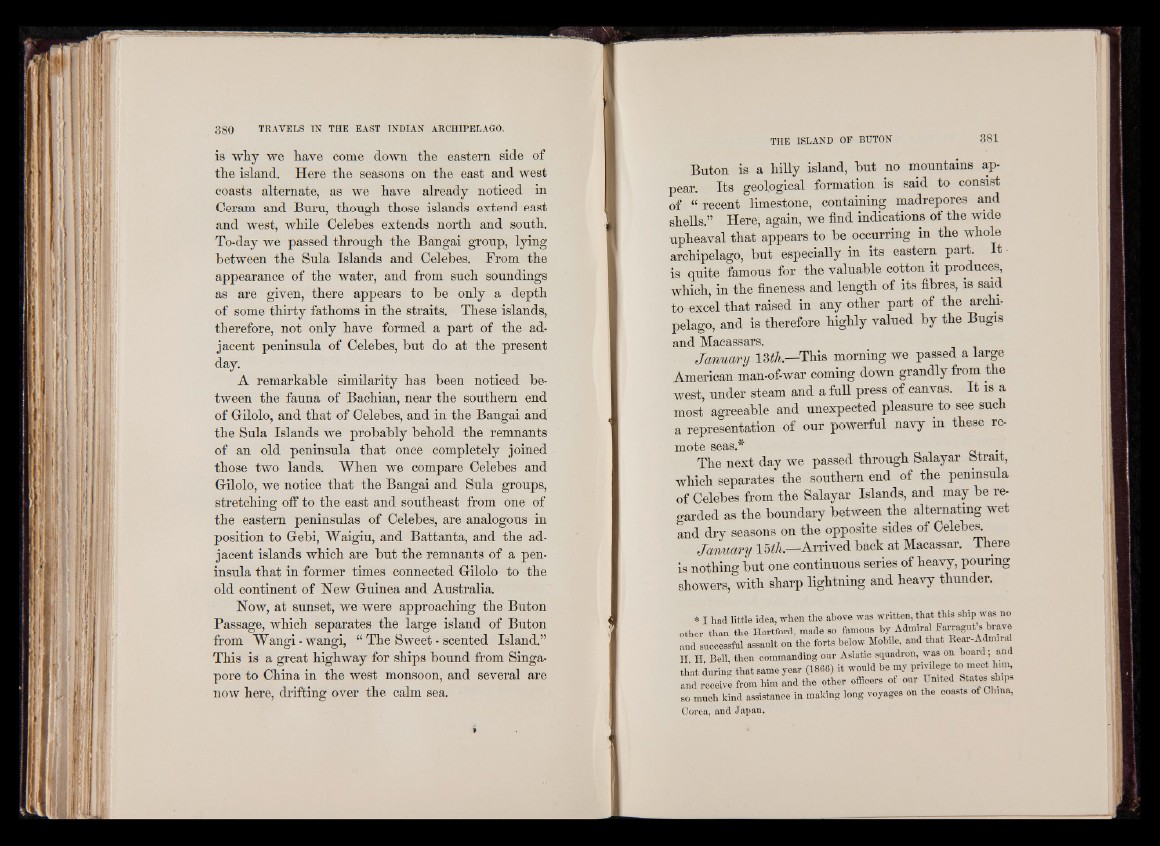
is why we have come down the eastern side of
the island. Here the seasons on the east and west
coasts alternate, as we have already noticed in
Ceram and Buru, though those islands extend east
and west, while Celebes extends north and south.
To-day we passed through the Bangai group, lying
between the Sula Islands and Celebes. From the
appearance of the water, and from such soundings
as are given, there appears to be only a depth
of some thirty fathoms in the straits. These islands,
therefore, not only have formed a part of the adjacent
peninsula of Celebes, but do at the present
day.
A remarkable similarity has been noticed between
the fauna of Bachian, near the southern end
of Gilolo, and that of Celebes, and in the Bangai and
the Sula Islands we probably behold the remnants
of an old peninsula that once completely joined
those two lands. When we compare Celebes and
Gilolo, we notice that the Bangai and Sula groups,
stretching off to the east and southeast from one of
the eastern peninsulas of Celebes, are analogous in
position to Gebi, Waigiu, and Battanta, and the adjacent
islands which are but the remnants of a peninsula
that in former times connected Gilolo to the
old continent of New Guinea and Australia.
Now, at sunset, we were approaching the Buton
Passage, which separates the large island of Buton
from Wangi-wangi, “ The Sweet - scented Island.”
This is a great highway for ships bound from Singapore
to China in the west monsoon, and several are
now here, drifting over the calm sea.
Buton is a hilly island, but no mountains appear.
Its geological formation is said to consist
of “ recent limestone, containing madrepores and
shells.” Here, again, we find indications of the wide
upheaval that appears to be occurring in the whole
archipelago, but especially in its eastern part. It
is quite famous for the valuable cotton it produces,
which, in the fineness and length of its fibres, is said
to excel that raised in any other part of the archipelago,
and is therefore highly valued by the Bugis
and Macassars.
January 13 ¿A.—-This morning we passed a large
American man-of-war coming down grandly from the
west, under steam and a full press of canvas. I t is a
most agreeable and unexpected pleasure to see such
a representation of our powerful navy m these remote
seas.*
The next day we passed through Salayar btrait,
which separates the southern end of the peninsula
of Celebes from the Salayar Islands, and may be regarded
as the boundary between the alternating wet
and dry seasons on the opposite sides of Celebes.
January 15 th.—Arrived back at Macassar. There
is nothing but one continuous series of heavy, pouring
showers, with sharp lightning and heavy thunder.
* I had little idea, when the above was written, that this ship was no
other than the Hartford, made so famous by Admiral Earragut’sbrave
and successful assault on the forts below Mobile, and that Rear-Admnal
H H Bell then commanding our Asiatic squadron, was on board; and
that during that same year (1866) it would be my privilege to meet him
and receive from him and the other officers of our United States ships
so much kind assistance in making long voyages on the coasts of China,
Corea, and Japan.